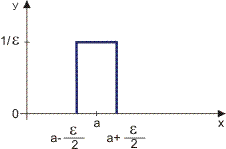The Dirac Delta Function δ(x - a) is an impulsive function defined as zero for every value of x, except for the point x ≠ a where it jumps to an infinitely large value. However, its graph encloses a unit area. It can be regarded as an idealization of a unit impulse. We define δ(x - a) through the following two properties:



This function has the following important property: for any continuous function f(x),

that is, δ(x - a) applied to f(x) detects its value at x = a.
We can heuristically show the validity of this property using the following argument: Let us approximate δ(x - a) through the function δε(x - a), such that:

which approaches δ(x - a) as ε tends to zero.
Clearly, the area covered by δε(x - a) is equal to one;

Furthermore, let F(x) be the primitive of f(x) (that is F'(x) = f(x)), then:

as ε goes to zero, the last expression defines the derivative of F(x) at x = a, which is precisely f(a).
The function δ(x - a) has a number of important applications in mathematical physics, in particular the solution of differential equations. In fact, it belongs to a class of generalized functions called distributions.
REFERENCES
Schwartz, L. (1973) Théorie des Distributions, Hermann, Paris.
References
- Schwartz, L. (1973) Théorie des Distributions, Hermann, Paris.
